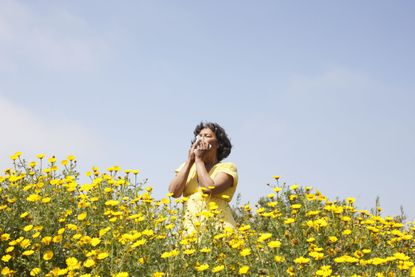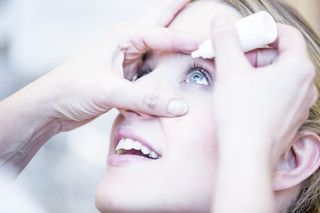How to cure your hay fever: hay fever symptoms, treatment and natural remedies
Are you one of the 18 million sufferers? We’ve got the facts to help you breeze through it…


Hay fever is more than just a sniffly nose and watery eyes. It now affects 30% of Brits every year; the highest rate in Europe.
The number of people suffering with hay fever is set to double by 2030 as well, with an explosion of new middle-age sufferers dealing with hay fever symptoms. And this year in particular, many people are reporting an spike in symptoms as the early Spring has helped to bring the pollen count up to its highest level since records began in 1951.
“Because it’s not life-threatening, studies and tests have been rather limited,” explains Shilpa Shah, pharmacist at Lloyds Pharmacy. But this doesn’t mean it should be trivialised.
“One study found its effects on your reflexes are the same as being over the blood alcohol limit for driving,” says Professor Adam Fox, a consultant allergist. We reveal how you can crack down on this debilitating condition.
What is hay fever and what causes hay fever symptoms?
Hay fever is an allergic reaction to pollen, typically when it comes into contact with your mouth, nose, eyes and throat. “In tree and grass pollen there are proteins, which, when ingested, cause antibodies in you to burst and release histamine,” explains Shilpa. “It’s the histamine that causes all the typical symptoms.”
Making matters worse, there’s no evidence to suggest why some individuals are allergic to pollen and others not. But what we do know is case numbers are escalating. Climate change has played its part. Thanks to rising temperatures, our pollen seasons are lasting longer, starting as early as February and sometimes finishing as late as November – so our exposure has increased significantly. Our clean environments may be to blame too, encouraging midlife allergies to emerge.

Pollution doesn’t help either. High levels, which cause a blanket of smog, can stop pollen from escaping into the upper atmosphere. When hay fever gets serious Apart from the aggravating symptoms, hay fever and the release of histamines can be critical for asthma sufferers. Breathing in through your nose warms and moistens the air before it enters your airways. But when our nose becomes blocked, we breathe in through our mouth, so the air we’re inhaling is colder and drier, which can bring on coughing, wheezing and shortness of breath.
Sign up for the woman&home newsletter
Sign up to our free daily email for the latest royal and entertainment news, interesting opinion, expert advice on styling and beauty trends, and no-nonsense guides to the health and wellness questions you want answered.
Hay fever symptoms
Hay fever symptoms include, but aren't limited to:
- sneezing and coughing
- a runny or blocked nose
- itchy, red or watery eyes
- itchy throat, mouth, nose and ears
- loss of smell
- pain around your temples and forehead
- headache
- earache
- feeling tired
If you have asthma, you might also:
- have a tight feeling in your chest
- be short of breath
- wheeze and cough
Hay fever will last for weeks or months, unlike a cold, which usually goes away after 1 to 2 weeks.
Hay fever treatment
There is supposedly a hay fever vaccine coming in the next couple of years, but this is a long way off for those already suffering from itchy, watery eyes and a streaming nose. Try these over-the-counter medications. Shilpa suggests combining eye drops, a nasal spray and antihistamines as a three-pronged attack
Opticrom Hay Fever Eye Drops, £5.29 for 10ml
Starts to soothe and relieve redness, itchiness, puffy eyes, and irritation in as little as two minutes.

A.Vogel Pollinosan Luffa Nasal Spray, £7.99 for 20ml
This works by rinsing and cleansing your nose of hay fever causing allergens.
LloydsPharmacy Allergy Reliever, £19.99
Try something different – this is designed to use red light therapy to suppress the cells that release histamine.
Natural remedies
Do you usually stream your way through spring and summer? Try these natural remedies to prevent symptoms…
Shower at night
Been out all day? Chances are you’ll have dragged the outside in, including sticky pollen, which could exacerbate symptoms. “Wash your hair and change your clothes, so you don’t spread pollen around your home or leave it on your pillow,” says Shilpa.
A spoonful of honey…may help your symptoms go down
Eating a local variety has long been suggested to help sufferers become immune to pollen’s irritating effects. The jury’s still out on whether it actually works, but at least the syrup can help soothe a scratchy throat.
Use Vaseline
“Rubbing a small amount of Vaseline around your nostrils can help trap pollen before it enters your nose,”explains Shilpa. Apply first thing before you head outdoors and before you go to bed to prevent lingering pollen inducing a sneezing fit during the night.
Pick your plants
Yes, you can still stop and smell the roses. Plants and flowers, such as magnolia, cherry blossom and roses, are pollinated by insects, rather than the wind, so are less likely to aggravate symptoms. And houseplants can even alleviate itchy eyes and a runny nose. Plants like the Peace Lily and Spider Plant not only catch pollen but also act as filters, getting rid of toxic air pollutants.
Ban booze
Alcohol suppresses your immune system, making it harder for your body to fight an allergy. Can’t bear going teetotal? Avoid red wine, as it’s naturally high in histamines, which can exacerbate symptoms.
Try the prick test
Your doctor will inject a small amount of allergens just below the surface of your skin, which should cause a reaction. Your GP can then determine what pollen allergy you’re suffering from.
Lauren is the former Deputy Digital Editor at woman&home and became a journalist mainly because she enjoys being nosy. With a background in features journalism, Lauren worked on the woman&home brand for four years before going freelance. Before woman&home Lauren worked across a variety of women's lifestyle titles, including GoodTo, Woman's Own, and Woman magazine.
-
 5 interior design trends from TikTok that homeowners regret trying
5 interior design trends from TikTok that homeowners regret tryingThese interior trends may have gone viral online but in real life, they were not so well-received
By Emily Smith Published
-
 Is Wicked Little Letters based on a true story? The real tale behind the film revealed
Is Wicked Little Letters based on a true story? The real tale behind the film revealedAs the darkly funny film arrives on Netflix, viewers have been curious about what inspired Wicked Little Letters
By Katherine Sidnell Published